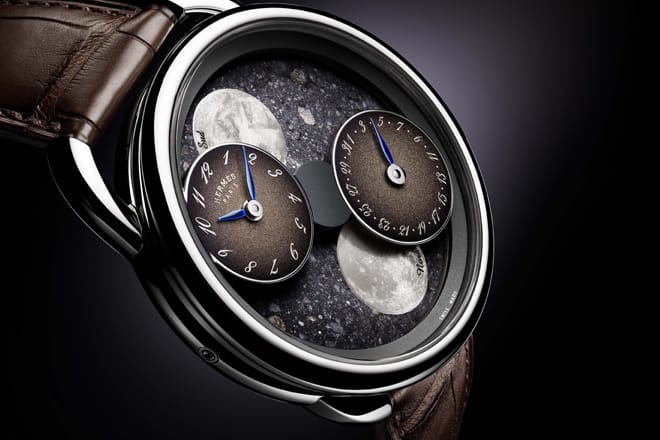
The watch terminologies and jargon in horology are almost as complicated as the mechanisms inside a watch. Terms coined in specialty websites and used by watch enthusiasts can be difficult to decipher, especially for those with little knowledge of what they mean in watch context. The crown is not an ornamental headpiece worn by a monarch, while a jewel has functional use instead of merely being beautiful to look at. You get what we mean now?
With that said, we decided to start a watch glossary that hopefully spares you the blushes when conversing about watches, but more importantly, to share the knowledge of this age-old industry.
—
Annual Calendar: A complication that only requires one manual adjustment per year, when February gives way to March.
—
Automatic Watch : A mechanical watch that winds by the wearer’s wrist motions, rather than by manually winding the crown. The wrist motion moves the rotor that then powers the mainspring, which turns the watch’s gears.
—
Balance Wheel: A weighted wheel that oscillates at a constant rate (usually one oscillation per fraction of a second), moving the watch’s gears and allowing the hands to move forward.

The gold portion is the balance wheel, within it lies the balance spring.
—
Balance Spring: A delicate spring (often made from metal but sometimes silicon) attached to the balance wheel that regulates the rate at which a balance wheel oscillates. The balance spring is also often referred to as a hairspring.
—
Barrel: A cylindrical device that houses the mainspring, which essentially is the watch’s power reserve. A watch’s power reserve can be expanded by adding additional barrels or increasing the size of the mainspring.
—
Bezel: The bezel is either a fixed or rotatable ring that surrounds the watch crystal. Some are purely decorative while others functional. (Learn more about different kinds of bezels here.)

Omega Co-Axial Master Chronometer Calibre 9905
—
Bezel Insert: The material that fills the bezel. A bezel insert can be made from various materials, ceramic being a popular option currently.
—
Bracelet: A metal band that holds the watch to the wrist. (Learn more about bracelets and straps here.)
—
Bridge: A plate mounted to the mainplate with screws, that holds wheels or other components in place.
—
Calibre: Also known as movement. A calibre is most often used to denote a specific movement from a watch manufacturer.
—
Case Back: The rear side of a watch case that can be removed to access the movement and insides of the watch. A see through case back allows one to view the movement while a closed case back does not.
—
Chronograph: A watch that features the stopwatch complication in addition to the main time. A chronograph is activated via a set of pushers protruding from the side of the case, usually flanking the crown.
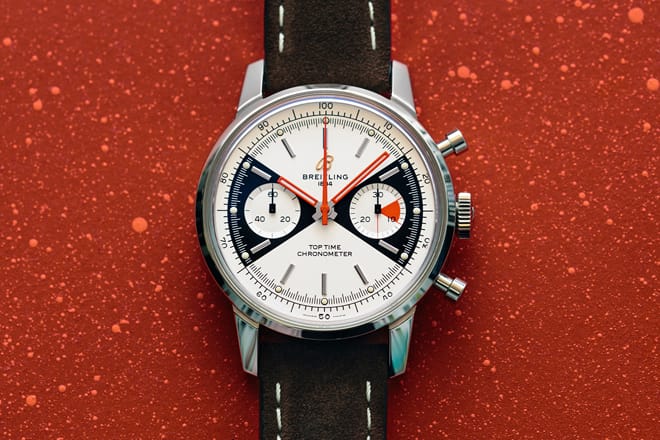
The Breitling Top Time Limited Edition features a chronograph and is also rated as a chronometer
—
Chronometer: A watch that is accurate to within -4/+6 seconds per day for mechanical watches and ±0.07 per day for quartz watches that is certified by independent organisations such as the Swiss COSC or German Glashütte Observatory. Some manufacturers regulate their watches to be within chronometer standards but do not send them for tests.
—
Complication: An additional function of a watch that goes beyond basic time telling. It can be as complex as a minute repeater, perpetual calendar which are known as grand complications or as simple as the date indicator. Other examples include a chronograph, moonphase indicator, GMT or a tourbillon. Complications require additional parts and make a watch more expensive and complex to build.
—
COSC: The Swiss agency Contrôle Officiel Suisse des Chronomètres (COSC) that is in charge of testing and certifying all Swiss chronometers.
—
Crown: The knob on the side of the watch case that is used to adjust the time, date and to wind the watch.
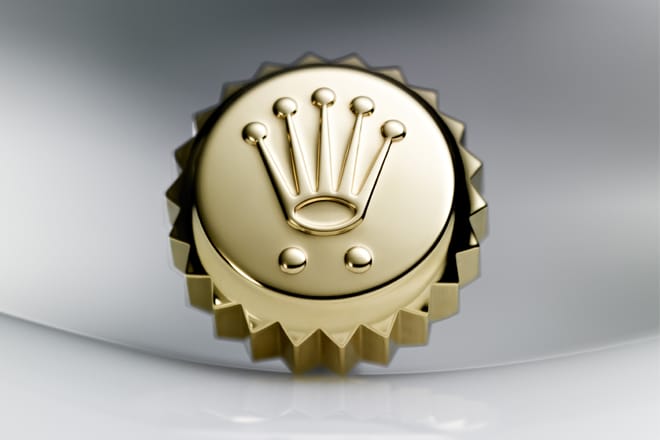
A coronet set on the winding crown
—
Crystal: The clear protective cover that protects the watch dial, made from either synthetic sapphire, mineral or acrylic. Synthetic sapphire is more scratch resistant than either acrylic or glass crystals but is the most expensive to produce.
—
Dial: Also often referred to as the face, the dial displays the time and features numerals and indexes as well as the hands. (See some of our favorite dial designs here.)
—
Dive Watch: A dive watch is a water-resistant watch that is usually rated to be 200m and above; not all water-resistant watches are dive watches. Other features of a dive watch include illumination on the hands and indexes as well as a dive bezel. There is an international standard for dive watches — ISO 6425.

The Rado Captain Cook 300m
—
Escapement: A component in a mechanical watch that manages the release of power from the mainspring that can be regulated by the balance wheel and hairspring. This component is responsible for a watch’s ticking noise.

The escapement
—
Frequency: The speed at which a watch ticks (or beats), measured in either vibrations per hour or hertz. Most modern watches beat at a frequency of 28,800 vph (4Hz) or 21,600 vph (3Hz). Watches that beat at 36,000 vph (5Hz) or higher are considered to be high-beat watches. A watch’s frequency is controlled by the oscillations of its balance wheel; the faster the oscillations, the more accurate the watch is. Some manufacturers decrease the frequency to increase the watch’s power reserve.
—
Gasket: A rubber ring used to seal the gaps between the case and the case back, crystal and crown to prevent water or dust from entering the case and damaging the movement inside.
—
GMT Watch: A complication that allows the watch to track two different time zones, usually with a fourth hand, the GMT hand.

TAG Heuer Aquaracer GMT
—
Hacking Seconds: This function stops the seconds hand when the crown is pulled out. This makes it easier to synchronize a watch with another timepiece.
—
Hand winding Watch: A mechanical watch that requires the wearer to manually wind the mainspring of the watch by turning the crown. Also known as a manual winding watch.
—
Haute Horlogerie: Translated to English, this French term means “high watchmaking,” and is used to distinguish watches or watchmakers that demonstrate extreme proficiency in watch design, technical innovation and finishing.
—
Horology: The study and measurement of time.
—
Indices: The markings on the dial of a watch used to represent the hours in place of numerals. Some manufacturers use applied indices which are attached to the dial, rather than printed on.
—
Jewels: Synthetic rubies used in a watch movement to reduce friction between moving parts and increase a movement’s lifespan. Complex movements with more movable components will have a higher jewel count.
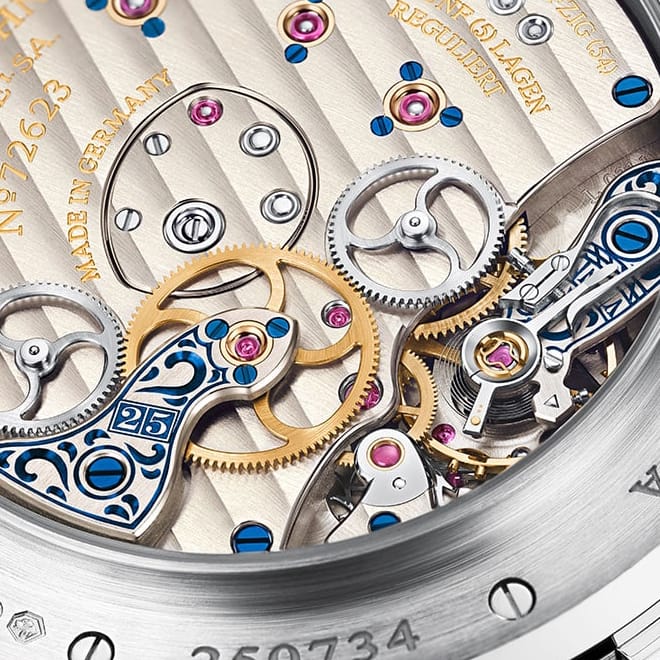
The bright red elements are the jewels of a watch movement, as seen on the A. Lange & Söhne Lange 1 Timezone “25th Anniversary“
—
Lugs: The protruding pieces of metal at the top and bottom of a watch case where the strap is attached. The two ends of the lug which holds the strap in place, secured by a spring bar.
—
Luminescence: Luminescence is the glow given off by watch numerals, indices and hands that have been coated with a luminescent material. Light is required to “charge” the luminescent material before it is capable of glowing in low light conditions. Colloquially referred to as “lume.”
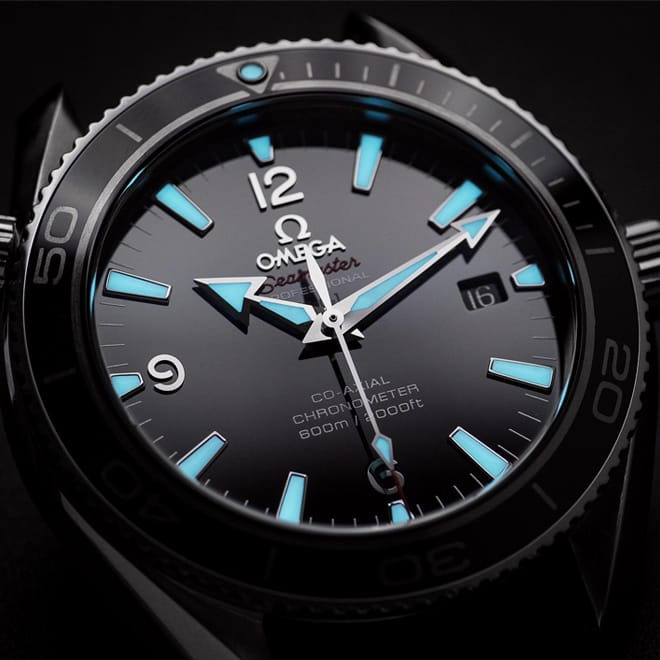
Blue lume as seen on the hands and applied indices of the Omega Seamaster
—
Magnetism: One of the nemesis of mechanical watches. Metal components inside a watch can often be magnetised resulting in a serious loss of accuracy. A common problem is having the balance spring magnetised, which affects the frequency of the watch. It is an easy fix with a demagnetiser. Some watches have soft-iron cages to protect the movement from magnetic fields, or use anti-magnetic silicon balance wheels.
—
Mainplate: The base on which all the components of a mechanical watch movement are mounted.
—
Mainspring: A spring that becomes tightened when a watch is wound, thus storing the energy of a watch. The force of the spring unwinding powers the watch. The mainspring is housed inside the barrel.
—
Manufacture: A shortened form of the French term “Manufacture d’Horologie”. Refers to a watch company that develops its own parts (including its movements) at its own facility (“in-house”), rather than assembling watches from parts made by third-party part suppliers.
—
Minute Repeater: A grand complication that chimes the hours and minutes through hammers and gongs when actuated.
—
Moonphase Indicator: A complication that shows the different sunlit phases of the moon viewed from earth when adjusted correctly.
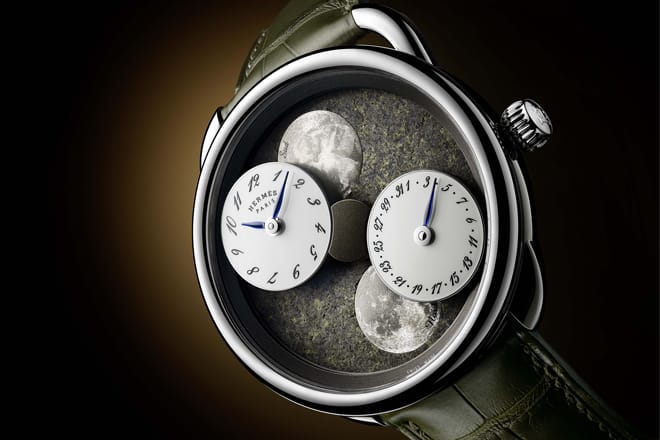
The Hermès Arceau L’Heure De La Lune with an interesting moonphase indicator
—
Movement: The entire mechanism of a watch, that can be either mechanical (automatic or hand winding) or quartz (battery powered). Most watch manufacturers refer to their movements as calibres. An in-house movement is one made by the brand’s own facility while a third-party movement is supplied by suppliers such as ETA or Miyota.
—
Perpetual Calendar: A grand complication that automatically accounts for leap years and date changes without manual adjustments.
—
Power Reserve: The length of time that a mechanical watch can run once it’s fully wound. The average is 40 hours though most entry-level watches have a power reserve of about 40 hours, while others are capable of running longer. Reducing the frequency or increasing the barrels can increase a watch’s power reserve.
—
Power Reserve Indicator: Often positioned on the dial, the power reserve indicator acts as a “fuel gauge” for the watch, indicating if the power reserve is full or empty.
—
Pusher: Usually found on chronograph watches that starts, stops and/or resets the chronograph mechanism. The majority of chronographs have two pushers — one to start and stop while the other for resetting. A monopusher chronograph features only a single pusher, that works in this order — start, stop and reset. Some brands use pushers for other purposes such as adjusting the date (A. Lange & Söhne Lange 1) or controlling the hour hands (Patek Philippe Nautilus Ref. 5990/1A).
—
Quartz Watch: A battery-powered watch that uses a quartz oscillator to control the watch frequency. Quartz watches are considerably more accurate because they operate at a very precise rate compared to mechanical watches.
—
Retrograde: An indicator on a watch dial that indicates a function in an arc or semi circular fashion. When the indicator reaches the end of the arc, it snaps back to the starting point. The retrograde indicator can be employed for hours, minutes, dates or the day of the week.

The Longines Master Retrograde Moonphase with various arc retrograde complications such as the date, day indicator and seconds hand
—
Rotor: A rotating weight attached to the back of an automatic movement that winds the watch via the wearer’s hand motion.
—
Self-winding Watch: Another term used for automatic watches because the watches winds itself.
—
Silicon: An anti-magnetic and thermally stable material that is gaining popularity in watchmaking (mostly in balance springs and escapements). Watches with silicon components are more accurate as they are not affected by magnets and temperature fluctuations.
—
Strap: A piece of leather, rubber or fabric that holds the watch to the wrist.
—
Skeleton Watch: A skeleton watch shows off the inner workings of the watch from the front of the watch. A full skeleton watch maintains only the essential mainplate while a partial skeleton watch reveals certain portions of the movement.
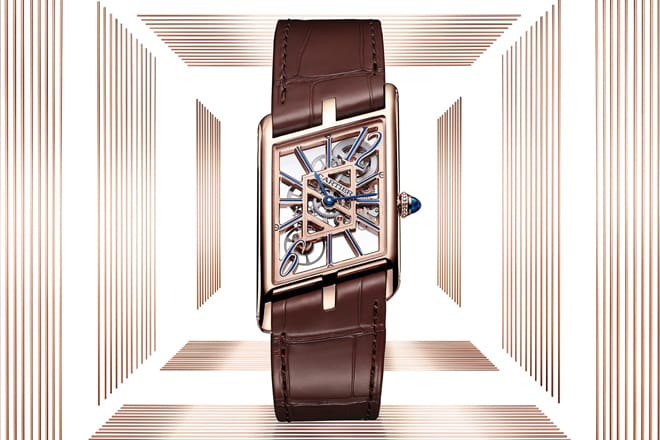
The Cartier Privé Collection Tank Asymétrique Skeleton
—
Small Seconds: A small sub-dial separate from the main hour and minute function that displays the seconds.
—
Sub-dial: A portion of the dial that displays other pieces of information. It could be a chronograph or a calendar sub-dial.
—
Tourbillon: A rotating cage that houses the escapement to counter the negative effects gravity on a movement. The complication was originally intended for pocket watches as they sat in a fixed position for prolonged periods. Presently it serves as a visual spectacle and demonstration of a brand’s technical prowess as our hand movements naturally negate the effects of gravity on the escapement.
—
Worldtime Watch: A watch with an adjustable dial that can be adjusted to show the time in 24 different time zones represented by 24 major cities across the globe.





